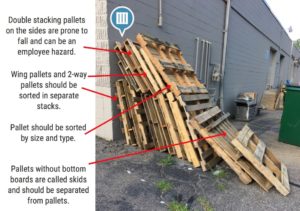February Safety Tip
How to Properly Store a Stack of Empty Pallets
Stacking Pallets Can Be a Hazard – Learn How to Do it Safely!
Most distribution and many manufacturing operations must deal with empty pallets – sometimes it’s a lot of pallets.
They take space you could use for something else and clutter receiving areas. Sometimes they have splinters or nails protruding from the sides. Pallets are often reused and stored for a period of time until needed for an outbound shipment. But while they’re in your facility, they can eat space, potentially injure people, and generally present some risks.
Never Stack Pallets on Their Sides
Why would you ever stack empty pallets vertically? They don’t take up any more space than pallets stacked the right way.
But people wedge a couple of vertical pallets between stacks of horizontally stacked ones to get them out of the way. Or they’ll lean them against a building column or the side of a rack upright. The problem? They’ve just set a trap that can injure someone. When the stacks start being pulled, those vertical pallets – sometimes with nails, sometimes with splinters, always heavy enough to injure – are in danger of tipping over.
This can result in serious injuries.
While there is no specific OSHA standard pertaining directly to vertical pallet stacking, inspectors can and do cite companies who engage in it. It may fall under OSHA 1926.25(a), under housekeeping. If a practice creates a potential safety hazard the rule can be applied to any operation. It’s a generally acknowledged safety problem with an easily rectified situation.
Make it a company policy that pallets must never stack on their sides, and never leaned against anything. The safe way is flat on the bottom, every time.
Never Stack Pallets Too High
According to OSHA standard 1917.14, “Cargo, pallets and other material stored in tiers shall be stacked in such a manner as to provide stability against sliding and collapse.”
This covers a lot of ground, including the way they are stacked (haphazardly, in mixed sizes, etc.). But the main focus here should be on height. How high is too high? According to OSHA, for a freestanding stack, that comes to 15 feet. Even that can be too high in a busy traffic lane. When a standard GMA pallet is 48″ x 40″, and has a height (which varies) of 5″ to 7″ from floor to top of deck, this means 20-25 empty pallets in a stack. Each pallet can weigh 55 pounds, so by regulation, you could have an unsecured stack that weighs up to 1,375 pounds.
Generally a more modest six foot stack is preferred and works better if the pallets are handled manually. It’s also recommended that pallet stacks higher than six feet should be protected by automated sprinkler systems (per National Fire Protection Association (NFPA) 13, Standard for the Installation of Sprinkler Systems.).
Never Stack Pallets Crookedly, or in Varying Sizes
Poor pallet stacking could be characterized as the world’s most dangerous Jenga game; if your pallets are in poor condition, if they aren’t uniform in size, and if they are stacked haphazardly, they can tumble or break. At 55 pounds a pallet, that’s an injury waiting to happen, even if the pallets are in great condition.
The point: stack pallets in very straight stacks, and stay at relatively low heights. It’s better to eat a bit of floor space than it is to create a safety hazard. You can also use pallet stacking frames or stacking racks to help stabilize them.
Pallet stacks should be separated by at least eight feet, and should be separated from general inventory by 25 feet.
One way to deal with a mass of pallets without covering your staging areas in stacks is to use dead space. While you typically don’t have the rack space to store idle pallets, many facilities have had success with over-dock-door pallet storage racking. This is often unused space, and can be converted to pallet storage with specialized racks.
Never keep or re-use damaged pallets
Damaged pallets are inherently unsafe. They are also a factor in product damage incidents. When a pallet is splintered on its ends, it has a good chance of cutting or scraping workers who handle it. When it has protruding nails or fasteners, it’s even more unsafe. If it’s missing boards, stringers, or other components, it can break under a load, or while being transported by forklift. It can tilt or lean while stored in racks. That’s unsafe for workers, and can result in a spilled pallet and lots of inventory damage.
Source: Cisco-eagle.com
For more details also see: http://repalletize.com/blog/26-pictures-analyzing-pallet-management-at-businesses

